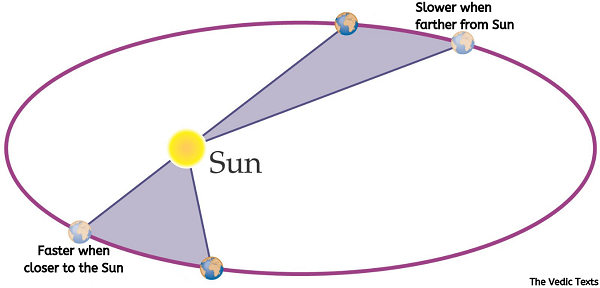In astronomy and Classical Mechanics, Kepler's laws of planetary motion describe the motion of planets in solar system. These laws were described by Johannes Kepler based on the observations of Danish Astronomer Tycho Brahe recorded in 16th century. Two planetary laws were described in 1609 and the third law was introduced in 1618. But interestingly, these planetary laws have already been discussed in our Vedas. Let's have a look over it.
Rigveda 10.149.1
सविता यन्त्रै∶ पृथिवीमरम्णादस्कम्भने सविता द्यामदृहंत् I
अश्वमिवाधुक्षद्धुनिमन्तरिक्षमतूर्ते बंद्ध सविता समुद्रम् II
अर्थात "अपने कर्म-साधन द्वारा पृथ्वी को स्थिर करने वाले हे सविता ! तू सृष्टि का उत्पादक है और बिना आधार (स्तंभ) के आकाश को तू सुदृढ़ रूप से अंतरिक्ष में स्थापित करता है तथा आधार रहित अंतरिक्ष में स्थित जलराशि के रूप में पाशयुक्त अश्व की भांति प्रकंपित शरीर वाले मेघों को बरसाता हैΙ"
अर्थात "अपने कर्म-साधन द्वारा पृथ्वी को स्थिर करने वाले हे सविता ! तू सृष्टि का उत्पादक है और बिना आधार (स्तंभ) के आकाश को तू सुदृढ़ रूप से अंतरिक्ष में स्थापित करता है तथा आधार रहित अंतरिक्ष में स्थित जलराशि के रूप में पाशयुक्त अश्व की भांति प्रकंपित शरीर वाले मेघों को बरसाता हैΙ"
Savita = Sun
Yantraih = through reins
Prithiveem = Earth
Aramnaat = ties
Dyaam Andahat = other planets in Sky
Atoorte = unbreakable
Baddham = holds
Ashwam Iv Adhukshat = like horses
The Sun has tied Earth and other planets through attraction and moves them around itself as if trainer moves newly trained horses around itself holding their reins. The motion of planets around Sun is not circular although planets are attracted towards Sun by a central force which results in their motion. Simply "All the planets of the solar system revolves around the Sun in elliptical orbits having Sun as one of the foci".
Rigveda 8.12.28
यदा ते हर्यता हरी वावृधाते दिवेदिवे Ι
आदित् ते विश्वा भुवनानि येमिरे ΙΙ
हे इंद्र ! जब तेरा बलशाली अश्व अत्यंत वृद्धि को प्राप्त हुआ, तब तूने संसार को अपने नियंत्रण में कर लिया।
Yada Te = When they
यदा ते हर्यता हरी वावृधाते दिवेदिवे Ι
आदित् ते विश्वा भुवनानि येमिरे ΙΙ
हे इंद्र ! जब तेरा बलशाली अश्व अत्यंत वृद्धि को प्राप्त हुआ, तब तूने संसार को अपने नियंत्रण में कर लिया।
Yada Te = When they
Haryataa = come closer via attraction
Hari = closeness
Vaavridhate = increases proportionally
Divedive = continuously
Vishwa Bhuvani = planets of world
Aditte = eventually
Yemire = remain stable
O Indra! You put forth your mighty rays and the entire universe is in order by the power of your attractive rays. All planets remain stable as they come closer to Sun due to attraction, their speed of coming closer increases proportionally. The velocity of planets around Sun is in inverse relation with the distance between Sun and Planet.



